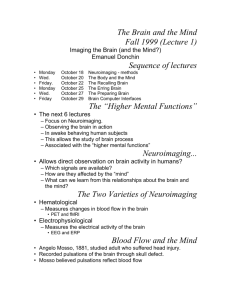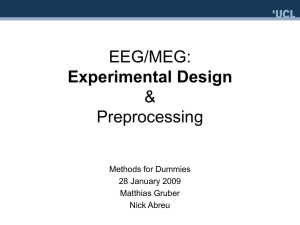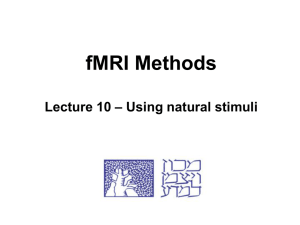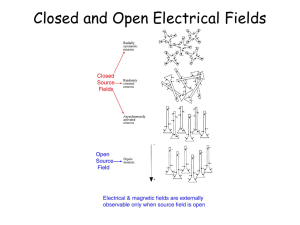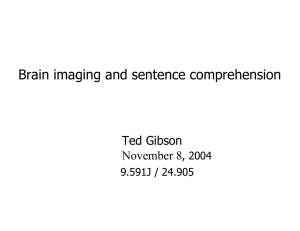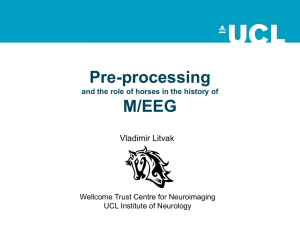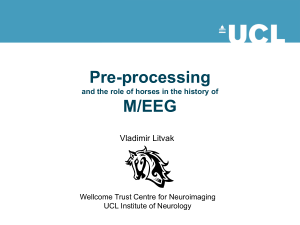Neuroimaging for Cognitive Research
advertisement
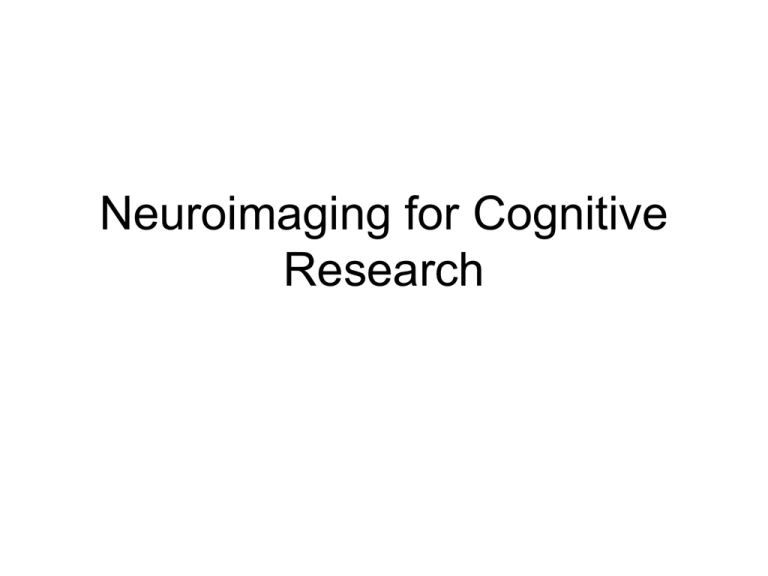
Neuroimaging for Cognitive Research Obtaining evidence from the Brain • Lesion studies (ling. aphaisiology) • Neuroimaging (CT, PET, SPECT, fMRI, EEG, MEG) • Direct manipulation – cell recordings (single and array) – electrical stimulation – neurochemical stimulation (barbiturates - Wada) Imaging Approaches Functional Structural MRI X-ray fMRI SPECT PET CT/CAT EEG ECG Electro-Encephalograghy (EEG) • Electrical current originating in the cortical areas • Measured across scull and tissue - adjustments for physical properties - + current EEG • Strengths: – Relatively easy to administer and cheap – High temporal resolution (miliseconds) • Weaknesses – Hard to interpret (noise, artifacts) – Low spatial resolution EEG signal analysis • Event Related Potentials (ERP) • Electrical activity on an electrode or a group of electrodes averaged over many trials • Positive and negative peaks at different points in time from the stimulus presentation • 0-150 ms - perception • 150-350 ms - phonological/syntactic • 350-600 ms - conceptual/semantic ERP temporal resolution From: brainvat.wordpress.com ERP spatial resolution ERP caveats • Signals from multiple sources (general body function unrelated to cognition) – Multiple presentations of the stimuli • Uncertainty of the signal source – Multiple “dipoles” may be responsible for the strength of signal at a given location – Source can be verified with other imaging methods (e.g., PET) ERP components • Three dimensional representation – Direction: Negative vs. Positive deflection – Latency: time from stimulus onset – Gross location: frontal, temporal, occipital, etc. • P1, N1, P2, N2, P3, N400, P600 ERP components P1 N1 P2 N2 P3 N400 P600 P1/N1 • P1 – 50ms – auditory, 100ms – visual – General attention/arousal • N1 – Selective attention to stimulus characteristics – Stimulus discrimination P2/N2 • P2 – obligatory cortical potential – Low individual variability and high reproducibility – Stimulus classification – Sensitive to pitch and loudness (auditory) • N2 – Stimulus discrimination – Deviation of stimulus from expectation P3 • Stimulus classification and response preparation • Varies with stimulus complexity • Possibly associated with memory and attention N400 • Sensitive to language (not music) specific anomalies • Semantic but not syntactic processing • May reflect the degree of anticipation/preactivation From Kutas & Hillyard 1980 P600 • Memory and language – Old-new response (greater for old information) – Syntactic Positive Shift (Kutas and Hilliard, 1983) • Syntactic processing load due to parsing failure • Elicited with syntactic and morphosyntactic violations (agreement, phrase structure, subcategorization, syntactic ambiguity) Magneto-Encephalography • Similar to EEG in some respects • Detects very weak magnetic fields resulting from electrical activity – – – – Earth - 1010 Urban noise - 1010 Epileptic spike - 1,000 Sensory evoked response - 100 • Tens of thousands of neurons firing in the same direction • Detected with Superconducting Quantum Interface Device (SQUID) • Orthogonal to EEG • Dipole source model - + current MEG • Strengths – High temporal resolution • Weaknesses – Sensitivity to magnetic interference – Hard to administer – Hard to interpret (noise, artifacts) MEG and synchronous cognitive networks Use Case: Study of Silent Meaning • Pylkkanen and McElree (JCN, 2007) • Semantic Compositionality – Strict/compositional version – semantics are always expressed in syntax – Alternative version – some semantic interpretations are non-compositional – independent of syntax Compositional vs. Noncompositional Meaning • The author began the article – Activity (writing) is implied – “Coerced complement” • The author wrote the article – Activity is explicit • The author astonished the article – Semantically anomalous Sources of Neural Response Results • Anterior Medial Field response (350500ms) sensitive to complement coercion • M350 component in the left temporal area is sensitive to semantic anomaly • Consistent with ERP findings for N400 component
